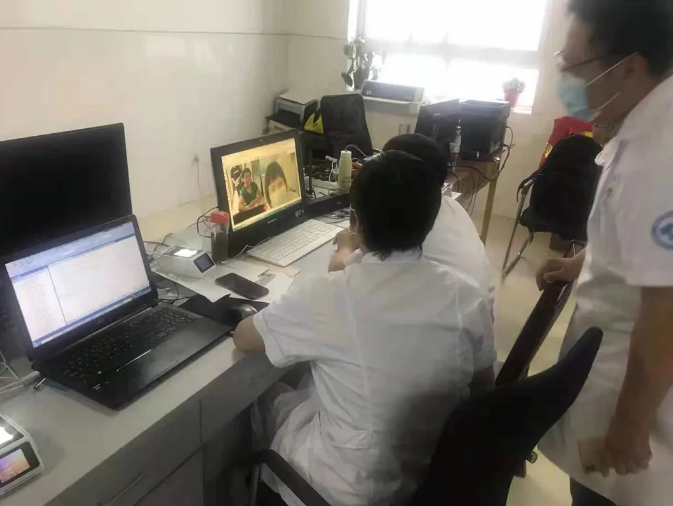Zhongguancun helps remote areas climb out of poverty

Lobsang Dolma introduces the breeding technology for Tibetan chickens to new employees at Deqingyuan Nyemo Tibetan Chicken Conservation Base in Tibet autonomous region. [Photo provided to chinadaily.com.cn]
Since 2018, more than 800 Zhongguancun companies have established more than 1,300 institutions in Beijing's counterpart poverty alleviation cooperation areas. These enterprises have invested 85 billion yuan ($ 13.17 billion) and explored a "science and technology +" poverty alleviation model integrating agriculture, medical care, tourism, consumption and education.
The high-tech enterprises in Zhongguancun focus on enhancing the economic development abilities of poverty-stricken areas and stimulating their internal motivation to boost their development.
Lobsang Dolma, 24, lives in Nyemo village, Nyemo township, Nyemo county, Lhasa city, Tibet autonomous region. Her family was originally a registered poverty-stricken household.
The five members of her family all depend on a few acres of land and temporary work. In 2015, the agro-industrial processing company Deqingyuan Ecological in Zhongguancun established a poverty alleviation industrial base in a joint venture with the local area and prioritized hiring people from impoverished local households.
By sorting eggs on the packaging line every day, Lobsang Dolma earns 5,200 yuan per month.
In the past few years, the "Golden Rooster Industry Poverty Alleviation Project" initiated by Deqingyuan has signed cooperation agreements with 25 poverty-stricken counties across the country. These agreements can lift 260,000 impoverished people out of poverty.
Zhongguancun technology enterprises also support impoverished areas by popularizing scientific and technological concepts, knowledge and skills.
Seven-year-old Qumuayi is a first-year student of Yifu Primary School in Saladipo township, Zhaojue county, Liangshan Yi autonomous prefecture, Sichuan province. Last year, he started to learn Mandarin from an AI teacher. One year later, he can already introduce himself and sing Chinese songs.
The high-tech educator is an "AI Teacher Mandarin Teaching System" developed by Tomorrow Advancing Life in Zhongguancun. The company uses its AI language instructor to teach Mandarin for free in Sichuan's Daliangshan Yi autonomous region.
The AI Mandarin teaching system now covers 72 primary schools, 252 teaching points and nearly 80,000 students in Zhaojue county. It not only helps elementary school students learn Mandarin but also corrects the pronunciation of local teachers and reduces their burdens.
Most impoverished areas are hidden in mountainous regions, where there is beautiful natural scenery.
To further promote the economy of poor areas, some internet platforms give full play to their advantages and support local "anchors" to share the beautiful scenery and specialties of their hometown.
These platforms provide a full set of plans for brand building, communication, promotion and talent training to help impoverished areas create new business opportunities for the cultural and tourism industry.
Wuyinga is a celebrity on the grassland of Xiwuzhumuqin Banner, Xilin Gol League, Inner Mongolia autonomous region.
In 2017, Wuyinga graduated from Inner Mongolia University of Finance and Economics and returned to her hometown.
Upon arriving home, she decided to join Douyin's targeted poverty alleviation project called "The beautiful scenery of China's mountainous areas.”
Later, Wuyinga opened the account "Prairie Impressions of Xilin Gol" on the video platform and introduced the Wuzhumuqin grasslands' natural scenery, ethnic customs and the daily life of herders through live webcasts and recorded videos.
Through her lens, the grassland's food, beautiful scenery, costumes and folk customs can be presented to the outside world, driving local tourism and the sales of agricultural and sideline products.

Doctors carry out telemedicine services through Huayiyun Health Poverty Alleviation Smart Diagnosis and Treatment Platform. [Photo provided to chinadaily.com.cn]
In terms of medical care, an enterprise in Zhongguancun established a smart hierarchical diagnosis and treatment platform in 2016.
The platform is centered on county-level medical institutions, connecting city-level, provincial-level and Beijing first-class hospitals with township healthcare centers and rural clinics.
A new service model of "inspection at the basic level, diagnosis and consultation at higher levels" was formed through the platform.
At present, the hierarchical diagnosis and treatment platform has taken root in seven provinces across the country, with over 2,700 medical institutions interconnected.
These free online diagnoses have covered more than 100 million people and saved more than 60 million yuan in medical expenses for the Chinese people.
